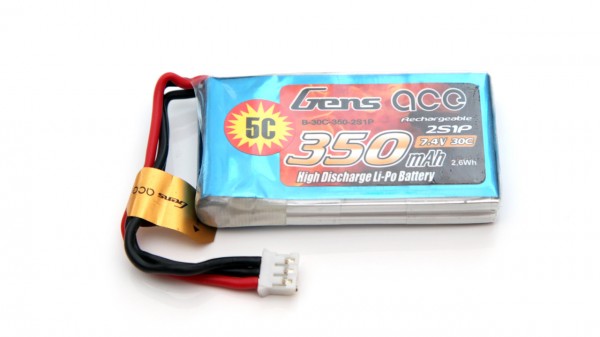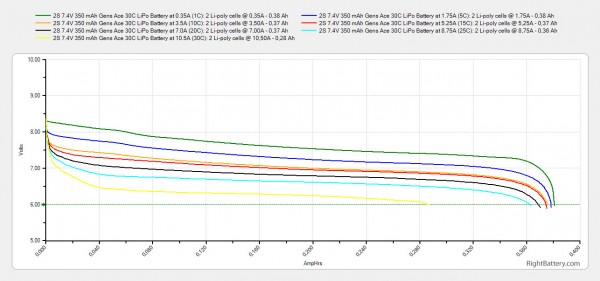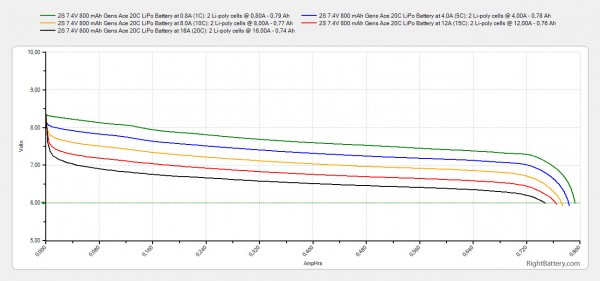RightBattery.com
Tests and reviews of different batteries to help you find the Right One…
Search
Posts Tagged ‘LiPo battery’
2S 7.4V 350 mAh Gens Ace 20C LiPo Battery Tests
15, Aug 2013
The 2S 7.4V 350 mAh Gens Ace 30C LiPo batteries are intended for use mostly in aircraft RC models such as helicopters and planes. These compact LiPo batteries have a pretty high discharge and charge ratings that we need to confirm in our tests. What is important to note is that the maximum discharge rates mentioned in the specifications are for quite high Amps and the small cables and connectors of the battery may not be able to handle them well.
Official Battery Specifications:
– Capacity: 350mAh
– Voltage: 7.4V
– Max Continuous Discharge: 30C (10.5A)
– Max Burst Discharge: 60C (21A)
– Weight: 25g
– Dimensions: 54,2×30,2×7,8 mm
– Balance Plug: JST-PHR
– Discharge Plug: n/a
– Charge Rate: 1-3C Recommended, 5C Max

Starting the tests with a 1C discharge rate (0.35A) for the 2S 7.4V 350 mAh Gens Ace 30C LiPo battery we’ve managed to get 381 mAh as a maximum capacity, a value that is about 9% higher than the official rating of the battery, so definitely a good thing here. Furthermore up to 25C constant current discharge rate the battery still manages to provide 363 mAh, still more than the rated capacity, though at that rate we’ve measured the battery ending up discharged with a temperature of 68 degrees Celsius or a bit high than the 60 degrees safe zone. The more serious problem however became apparent with the 30C constant current discharge rate test where 10.5 Amps need to pass through the small cables of the battery and this makes them very hot – up to 100 degrees and that is dangerous as they or the connector can melt and short the battery!
The performance of the 2S 7.4V 350 mAh Gens Ace 30C LiPo Battery in our tests:
– 381 mAh at 0.35A load (1C)
– 378 mAh at 1.75A load (5C)
– 376 mAh at 3.50A load (10C)
– 375 mAh at 5.25A load (15C)
– 370 mAh at 7.00A load (20C)
– 363 mAh at 8.75A load (25C)
– 287 mAh at 10.5A load (30C)
While the 2S 7.4V 350 mAh Gens Ace 30C LiPo batteries are capable of handling a constant discharge rate of up to 30C as their specifications say the battery cables used are not designed to properly handle the 30C constant discharge rate!
- In: Li-Po/Ion/Fe Batteries
- Tags: 2s lipo, 350 mAh, Gens Ace, Gens Ace battery, Gens Ace LiPo, LiPo, LiPo battery
2S 7.4V 800 mAh Gens Ace 20C LiPo Battery Tests
14, Aug 2013
The 2S 7.4V 800 mAh Gens Ace 20C LiPo batteries are intended for use in various RC models such as helicopters and planes. These compact LiPo batteries have a pretty high discharge and charge ratings that we need to confirm in our tests. What is important to note is that the maximum discharge rates mentioned in the specifications are for quite high Amps and the small cables and connectors of the battery may not be able to handle them well.
Official Battery Specifications:
– Capacity: 800mAh
– Voltage: 7.4V
– Max Continuous Discharge: 20C (16A)
– Max Burst Discharge: 40C (32A)
– Weight: 50g
– Dimensions: 56.37×30.74×18.76 mm
– Balance Plug: JST-XH
– Discharge Plug: JST
– Charge Rate: 1-3C Recommended, 5C Max

Starting the tests with a 1C discharge rate (0.8A) for the 2S 7.4V 800 mAh Gens Ace 20C LiPo battery we’ve managed to get 793 mAh as a maximum capacity which is a bit short from the rated capacity of 800 mAh though at less than 1% it is not a problem. Going for higher discharge rate the battery still manages to offer very good capacity even at 20C it handles pretty well with 749 mAh useable capacity. The problem however is that at 20C constant current discharge rate the cables of the battery get way too hot, we’ve measured 98 degrees Celsius and that is way too high. The cables getting hot are just an indication that the current passing through them is more than what they can safely handle.
The performance of the 2S 7.4V 800 mAh Gens Ace 20C LiPo Battery in our tests:
– 793 mAh at 0.8A load (1C)
– 784 mAh at 4.0A load (5C)
– 774 mAh at 8.0A load (10C)
– 765 mAh at 12A load (15C)
– 749 mAh at 16A load (20C)
While the 2S 7.4V 800 mAh Gens Ace 20C LiPo batteries are capable of handling a constant discharge rate of 20C as their specifications say the battery cables used are not desgned to properly handle the 20C constant discharge rate!
- In: Li-Po/Ion/Fe Batteries
- Tags: 2s lipo, 800 mAh, Gens Ace, Gens Ace battery, Gens Ace LiPo, LiPo, LiPo battery
2S 7.4V 250 mAh Gens Ace 30C LiPo Battery Tests
8, Aug 2013
The 2S 7.4V 250 mAh Gens Ace 30C LiPo batteries are compact batteries often used in small scale flying radio controlled models such as RC planes and helicopters. These small batteries have a pretty high discharge and charge ratings that we need to confirm in our tests. What is important to note for this particular battery is that it is a 2 cell battery, but there is no balance plug, only a JST discharge one that brings out the combined voltage from the two cells. While this normally should not be a big problem, not having a balance connector may shorten the life of the battery if the cells become more and more disbalanced over time.
Official Battery Specifications:
– Capacity: 250mAh
– Voltage: 7.4V
– Max Continuous Discharge: 30C (7.5A)
– Max Burst Discharge: 60C (15A)
– Weight: 18g
– Dimensions: 38,5mm*25,12mm*10,5mm
– Balance Plug: N/A
– Discharge Plug: JST
– Charge Rate: 1-3C Recommended, 5C Max

Time for the actual tests, starting with a 1C discharge rate (0.25A) for the 2S 7.4V 250 mAh Gens Ace 30C LiPo battery we’ve managed to get 264 mAh as a maximum capacity which is a value a bit higher than the rated 250 mAh capacity for the battery, so definitely a good thing. Furthermore at up to 20C discharge rate the battery still manages to provide more than the rated 250 mAh capacity and at 25C and 30C the capacity you can get is just a bit less than 250, but still quite close to that value. So the 30C constant discharge rate is confirmed, however we’ve decided not to go for tests at up to 60C that the battery is supposedly able to handle. The reason for that is the fact that at 25C discharge rate the battery had a temperature of 65 degrees Celsius and at 30C it got up to 71 which is out of the safety zone for working temperature.
The performance of the 2S 7.4V 250 mAh Gens Ace 30C LiPo Battery in our tests:
– 264 mAh at 0.25A load (1C)
– 263 mAh at 1.25A load (5C)
– 261 mAh at 2.50A load (10C)
– 255 mAh at 3.75A load (15C)
– 255 mAh at 5.00A load (20C)
– 244 mAh at 6.25A load (25C)
– 234 mAh at 7.50A load (30C)
We can conclude that the 2S 7.4V 250 mAh Gens Ace 30C LiPo batteries are performing very good and meet their specs, the only thing to note is that if you are going to be pushing to their maximum you should make sure they are cooled properly (at 25C-30C discharge rates).
- In: Li-Po/Ion/Fe Batteries
- Tags: 250 mAh, Gens Ace, Gens Ace battery, Gens Ace LiPo, LiPo, LiPo battery